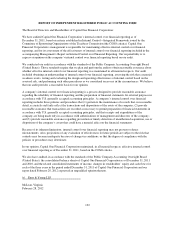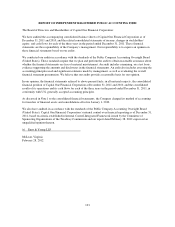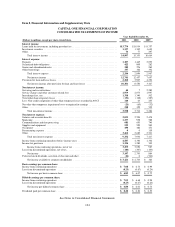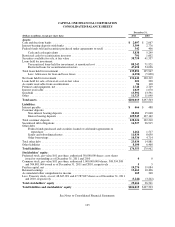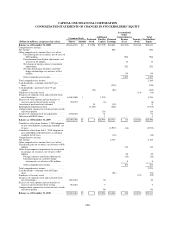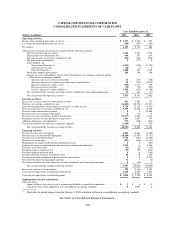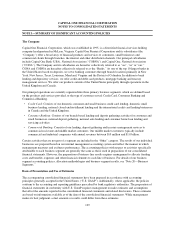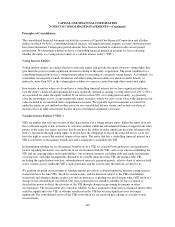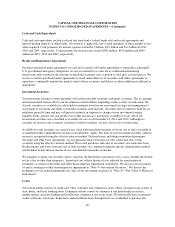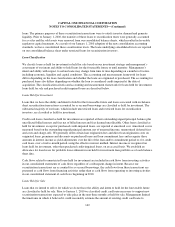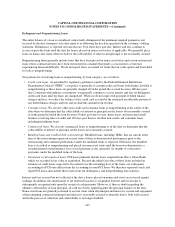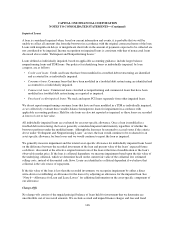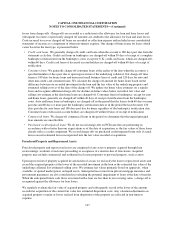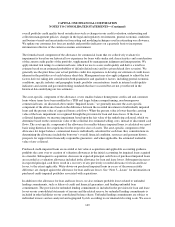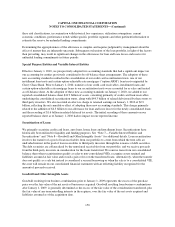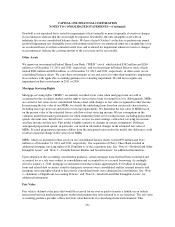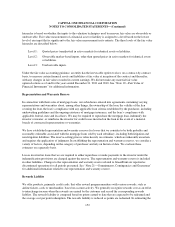Capital One 2011 Annual Report Download - page 162
Download and view the complete annual report
Please find page 162 of the 2011 Capital One annual report below. You can navigate through the pages in the report by either clicking on the pages listed below, or by using the keyword search tool below to find specific information within the annual report.CAPITAL ONE FINANCIAL CORPORATION
NOTES TO CONSOLIDATED STATEMENTS—(Continued)
loans. The primary purposes of these securitization transactions were to satisfy investor demand and generate
liquidity. Prior to January 1, 2010, the transfers of these loans to securitization trusts were generally accounted
for as sales and the sold assets were removed from our consolidated balance sheets, which resulted in favorable
regulatory capital treatment. As a result of our January 1, 2010 adoption of the new consolidation accounting
standards, we have consolidated these securitization trusts. The loans underlying consolidated trusts are reported
on our consolidated balance sheet under restricted loans for securitization investors.
Loan Classification
We classify loans as held for investment or held for sale based on our investment strategy and management’s
assessment of our intent and ability to hold loans for the foreseeable future or until maturity. Management’s
intent and ability with respect to certain loans may change from time to time depending on a number of factors,
including economic, liquidity and capital conditions. The accounting and measurement framework for loans
differs depending on the loan classification and whether the loans are originated or purchased. The accounting for
purchased loans also differs depending on whether the loan is considered credit-impaired at the date of
acquisition. The classification criteria and accounting and measurement framework for loans held for investment,
loans held for sale and purchased-credit impaired loans are described below.
Loans Held for Investment
Loans that we have the ability and intent to hold for the foreseeable future and loans associated with on-balance
sheet securitization transactions accounted for as secured borrowings are classified as held for investment. The
substantial majority of our loans, which include unrestricted loans and restricted loans for securitization
investors, are classified as held for investment.
Credit card loans classified as held for investment are reported at their outstanding unpaid principal balance plus
uncollected billed interest and fees net of billed interest and fees deemed uncollectible. Other loans classified as
held for investment, except for purchased credit-impaired loans, are reported at amortized cost. Amortized cost is
measured based on the outstanding unpaid principal amount, net of unearned income, unamortized deferred fees
and costs and charge-offs. We generally defer certain loan origination fees and direct loan origination costs on
originated loans, premiums and discounts on purchased loans and loan commitment fees and recognize these
amounts in interest income as yield adjustments over the life of the loan and/or commitment period or, for credit
card loans, over a twelve-month period, using the effective interest method. Interest income is recognized on
loans held for investment, other than purchased credit-impaired loans, on an accrual basis. We establish an
allowance for loan losses for probable losses inherent in our held for investment loan portfolio as of each balance
sheet date.
Cash flows related to unrestricted loans held for investment are included in cash flows from investing activities
in our consolidated statements of cash flows regardless of a subsequent change in intent. Because our
securitization transactions are accounted for as secured borrowings, the cash flows from these transactions are
presented as cash flows from financing activities rather than as cash flows from operating or investing activities
in our consolidated statement of cash flows beginning in 2010.
Loans Held for Sale
Loans that we intend to sell or for which we do not have the ability and intent to hold for the foreseeable future
are classified as held for sale. Prior to January 1, 2010 we classified credit card loans necessary to support new
securitization transactions expected to take place in the next three months as held for sale. Management limited
the timeframe in which it believed it could reasonably estimate the amount of existing credit card loans to
142


